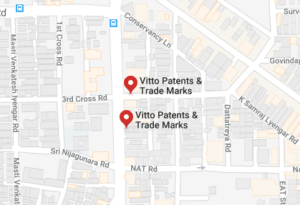COPYRIGHTS
GENERAL INFORMATION
Copyright is the exclusive right to reproduce / publish the work in any material form in case of an artistic or literary work /perform the work in public, when it is concerned with a dramatic or musical work and to copy the film in case of a cinematographic work and in case of records, to make any other record embodying the same recording.
Subject to exceptions mentioned latter, the owner of the copyright in a work has the exclusive right to undertake or authorize others to undertake
all or any of the following acts:
To copy the work, to make the work available to the public or to make an adaptation of the work. These acts are known as acts restricted by copyright,
and the undertaking of any of these acts by a third party amounts to infringement.
Author is the owner of the Literary work and an artist is the owner of an artistic work, conceived and developed by him. However, an application can be made in the name of a third party, showing him/her as the owner of the work, provided there is no objection from the Author/Artist of the Literary/Artistic work and there is a monetary flow from the owner of the work to the respective Author/Artist in consideration of the same. In such an event, it is mandatory that the respective Author/Artist gives a No Objection letter to the Registrar of Copyrights.
If the artistic or literary work is capable of being used as a trade mark, then it is mandatory that a Clearance Certificate has to be obtained from the Trade Marks Office by making a formal application on FORM TM-60. Such applications forwarded to the Copyright Office should always accompany a clearance certificate stating that there are no similar conflicting marks in the Register, failing which the application for copyright registration is liable to be rejected.
COPYRIGHT REGISTRATION PROCESS
Following are the various steps involved:
Step 1 – Every application for registration of copyright shall be made in Form-XIV and every application for registration of changes in the particulars of copyright entered in the Register of Copyright shall be made in Form-XV.
Step 2 – Every such application shall be in respect of one work only, and shall be accompanied by the fee specified in the Second Schedule in this behalf.
Step 3 – Every application should be signed only by the applicant, who may be an author or owner of right. If the application is submitted by the owner of copyright, it shall be enclosed with an original copy of no objection certificate issued by the author in his favour.
Step 4 – Every application for registration of an unpublished work shall be accompanied by two copies of the work.
Step 5 – Every application for registration of a computer programme shall be accompanied by the source and object code.
Step 6 – Every application for registration in respect of an artistic work which is used or is capable of being used 1[in relation to any goods or services], such application shall include a statement to that effect and shall be accompanied by a certificate from the Registrar of Trademarks referred to in section 3 of the Trade Marks Act, 1999, to the effect that no trademark identical with or deceptively similar to such artistic work has been registered under that Act in the name of, or that no application has been made under that Act for such registration by, any person other than the applicant.
Step 7 – Every application for registration in respect of an artistic work which is capable of being registered as a design under the Designs Act, 2000, such application shall be accompanied by a statement in the form of an affidavit containing the following, namely:
(a) it has not been registered under the Designs Act, 2000; and
(b) it has not been applied to an article through industrial process and reproduced more than fifty times.
Step 8 – Every such application can be filed in the Copyright Office by person or by post or by online filing facility as provided on the website of the Copyright Office.
Step 9 – The person applying for registration shall give notice of his application to every person who claims or has any interest in the subject-matter of the copyright or disputes the rights of the applicant to it.
Step 10 – If no objection to such registration is received by the Registrar of Copyrights within thirty days of the receipt of the application, the Registrar of Copyrights shall, if satisfied about the correctness of the particulars given in the application, enter such particulars in the Register of Copyrights.
Step 11 – If the Registrar of Copyrights receives any objections for such registration within the time specified in 2[sub-rule (10)], or, if he or she is not satisfied about the correctness of the particulars given in the application, he or she may, after holding such inquiry as he or she deems fit, enter such particulars of the work in the Register of Copyrights as he or she considers necessary.
Step 12 – The Registrar of Copyrights shall give an opportunity of hearing before rejecting the any application filed for registration of any work.
Step 13 – The process of registration is deemed to be completed only when a copy of the entries made in the Register of Copyrights is signed and issued by Registrar of Copyrights or by Deputy Registrar of Copyrights, to whom such authority is delegated.
Step 14 – The Registrar of Copyrights shall, as soon as may be, send, wherever practicable, a copy of the entries made in the Register of Copyrights to the parties concerned.
INTERNATIONAL COPYRIGHT REGISTRATION
International copyright regime has evolved to harmonize the copyright laws of different jurisdictions, to ensure greater transborder protection to the works and also in response to the challenges of technological development
Berne convention, aimed to protect the rights of the authors internationally, is built on three fundamental principles:
- Principle of national treatment
- Principle of automatic protection
- Principle of independence of protection
The works of the authors who are nationals of one contracting party shall be given the same protection that is accorded to the nationals in each other contracting parties.
This is the principle of national treatment. The protection accorded to the copyright does not depend upon fulfillment of any formality.
This non-formality rule is called as the principle of ‘automatic’ protection. The copyright protection given for a work in any contracting party is independent of the protection in the country of origin of the work. This is known as the principle of independence of protection.



